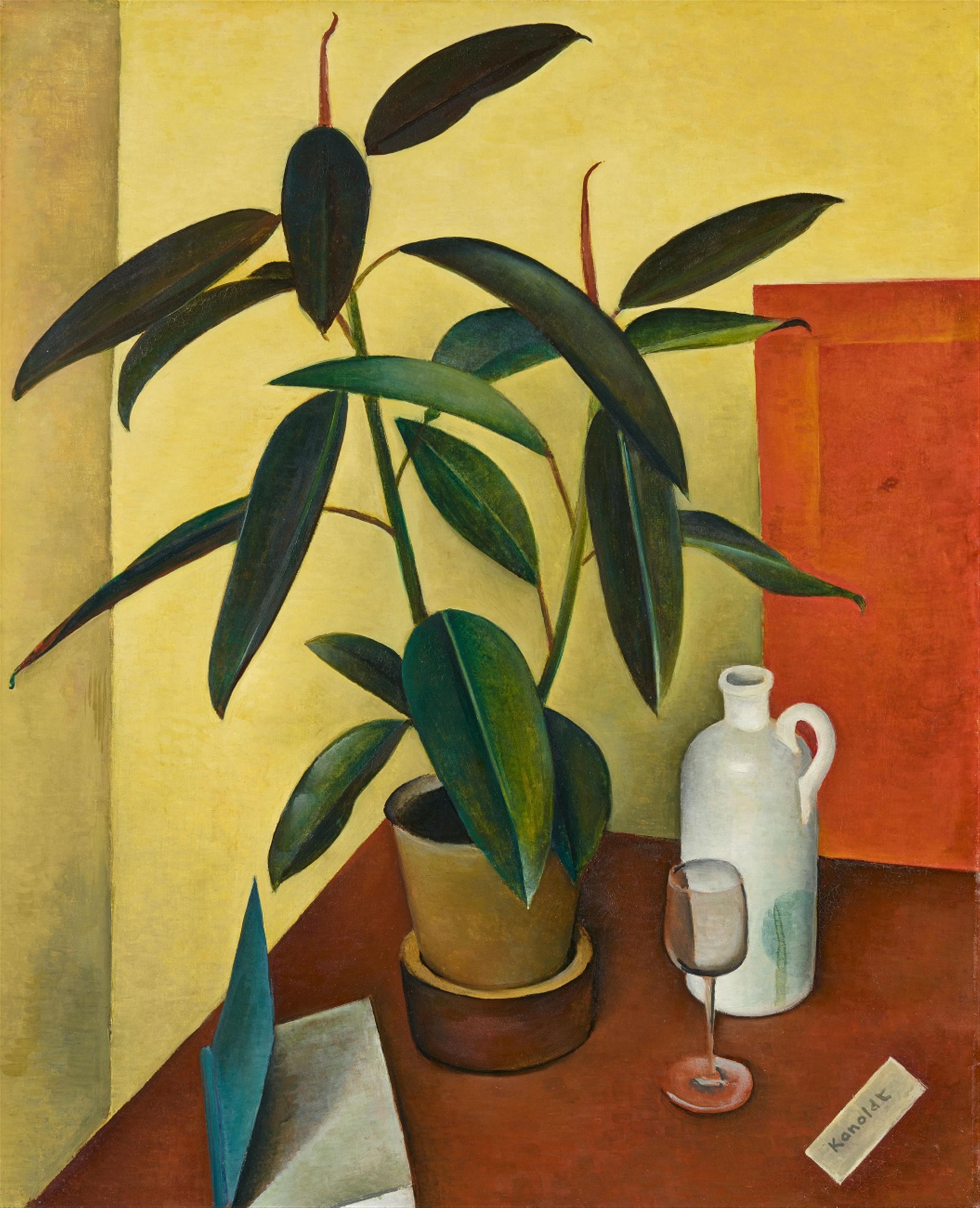Alexander Kanoldt
Stillleben I
1929
Oil on canvas 80.5 x 65.5 cm Framed. Signed 'Kanoldt' in black lower right on a bookmark and verso signed and dated 'Kanoldt I/1929' in black on the upper stretcher bar. - The right margin with a minor retouching.
In numerous ways this large-format still life by Alexander Kanoldt demonstrates itself to be a mature and characteristic work by the painter. In 1909 Kanoldt had founded the “Neue Künstlervereinigung” in Munich together with artists including Kandinsky, Jawlensky, Münter and Werefkin, and two years later “Der Blaue Reiter” would grow out of this association. Kanoldt had studied painting at the academy in Karlsruhe; after the First World War, together with his friend Georg Schrimpf, he turned to a clearer expressive idiom, which would later become known as the “New Objectivity”, named after the title of a 1925 exhibition organised by Gustav Friedrich Hartlaub, director of the Kunsthalle Mannheim. Kanoldt can be considered one of the main protagonists of this new artistic tendency so typical of the Weimar Republic, and his still lifes can be seen as its incunabula, so to speak.
They create variations on different arrangements of various everyday objects from his own home and studio. A hard-leafed plant, such as the rubber plant here, is practically unavoidable: its precise and smooth leaves were predestined for the New Objectivity's depersonalised form of representation. The objects' arrangement and overlapping extend a veritable invitation to viewers to take a seat at the table. The items become materialised in a rigid, sculptural form that becomes unsettled through oblique and shifting perspectives and views on to, into and through them. While the colour scheme featuring a complementary contrast of green and red conveys a harmonious general atmosphere, which fits optimally with the white of the ceramic jar, the entire space depicted in the picture has been made entirely unclear and does not correspond to any natural spatial structure. This invests the structure of the picture, which appears to be so clear, with an uncertainty that can accordingly be interpreted as a commentary on a political situation defined by turmoil. At the time he created this painting, Alexander Kanoldt was a professor at the state academy of fine and applied art in Breslau, however, this would not protect his works from the denunciations of the Nazis, which began just a few years later.
Catalogue Raisonné
Koch 29.4
Provenance
Bank director Ullmann, Wroclaw/Berlin; Leo Spik, Auction 567, Berlin, 9/11 December 1993, Lot 128; Galerie Sander, Darmstadt (with stretcher label verso); Private collecion, Hesse
Literature
Schlesische Monatshefte 6, 1929, with illus. p. 60; Hans Tietze, Neue Sachlichkeit in der bildenden Kunst, in: Westermanns Monatshefte 74, vol. 148, Braunschweig 1930, p. 384, with illus.; Brigitte Fischer-Hollweg, Alexander Kanoldt und die Kunstrichtungen seiner Zeit, Diss. Ruhr-Universität Bochum 1971, cat. no. M 69 (erroneously dated to 1925), p. 71 f., 110; Die Welt, no. 295, Berlin 18 Dec.1993, p.E 7 with illus.; Kunstpreis-Jahrbuch 49, vol.I, 1994, p. 688 with illus.; Weltkunst 64, 1994, with illus. p. 475; Elke Fegert, Alexander Kanoldt und das Stillleben der Neuen Sachlichkeit, Diss. Saarbrücken 2006 (Schriften zur Kunstgeschichte 21), Hamburg 2008, p. 349 ff., illus. 70
Exhibitions
Wroclaw 1929 (Staatliche Akademie Kunst und Kunstgewerbe), Ausstellung der Lehrenden; Munich 1929 (Glaspalast), Neue Secession - Frühjahrsausstellung, cat. no. 48

